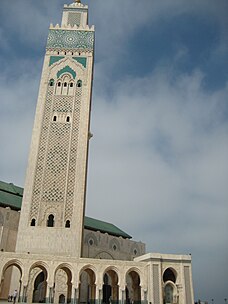
Back عمارة مغربية Arabic Arquitectura de Marruecos Spanish אדריכלות מרוקאית HE モロッコの建築 Japanese Seni bina Maghribi Malay Arkitettura Marokkina Maltese Marokkaanse architectuur Dutch Moroccan architecture SIMPLE Fas mimarisi Turkish
Moroccan architecture reflects Morocco's diverse geography and long history, marked by successive waves of settlers through both migration and military conquest. This architectural heritage includes ancient Roman sites, historic Islamic architecture, local vernacular architecture, 20th-century French colonial architecture, and modern architecture.
Much of Morocco's traditional architecture is marked by the style that developed during the Islamic period, from the 7th century onward. This architecture was part of a wider tradition of "Moorish" or western Islamic architecture, which characterized both the Maghreb (Morocco, Algeria, and Tunisia) and al-Andalus (Muslim Spain and Portugal).[1][2][3][4] It blended influences from Amazigh (Berber) culture in North Africa, pre-Islamic Spain (Roman, Byzantine, and Visigothic), and contemporary artistic currents in the Islamic Middle East to elaborate a unique style over centuries with recognizable features such as the horseshoe arch, riad gardens, and elaborate geometric and arabesque motifs in wood, carved stucco, and zellij tilework.[1][2][5][6]
Although Moroccan Amazigh architecture is not strictly separate from the rest of Moroccan architecture, many structures and architectural styles are distinctively associated with traditionally Amazigh or Amazigh-dominated regions such as the Atlas Mountains and the Sahara and pre-Sahara regions.[7] These mostly rural regions are marked by numerous kasbahs (fortresses) and ksour (fortified villages) shaped by local geography and social structures, of which one of the most famous is Ait Benhaddou.[8] They are typically made of rammed earth and decorated with local geometric motifs. Far from being isolated from other historical artistic currents around them, the Amazigh peoples of Morocco (and across North Africa) adapted the forms and ideas of Islamic architecture to their own conditions[9] and in turn contributed to the formation of Western Islamic art, particularly during their political domination of the region over the centuries of Almoravid, Almohad, and Marinid rule.[6][7]
Modern architecture in Morocco includes many examples of early 20th-century Art Deco and local neo-Moorish architecture constructed during the French and Spanish colonial occupation of the country between 1912 and 1956 (or until 1958 for Spain).[10][11] In the later 20th century, after Morocco regained its independence, some new buildings continued to pay tribute to traditional Moroccan architecture and motifs (even when designed by foreign architects), as exemplified by the Mausoleum of King Mohammed V (completed in 1971) and the massive Hassan II Mosque in Casablanca (completed in 1993).[12][13] Modernist architecture is also evident in contemporary constructions, not only for regular everyday structures but also in major prestige projects.[14][15]
- ^ a b Marçais, Georges (1954). L'architecture musulmane d'Occident. Paris: Arts et métiers graphiques.
- ^ a b Parker, Richard (1981). A practical guide to Islamic Monuments in Morocco. Charlottesville, VA: The Baraka Press.
- ^ Gaudio, Attilio (1982). Fès: Joyau de la civilisation islamique. Paris: Les Presse de l'UNESCO: Nouvelles Éditions Latines. ISBN 2723301591.
- ^ Touri, Abdelaziz; Benaboud, Mhammad; Boujibar El-Khatib, Naïma; Lakhdar, Kamal; Mezzine, Mohamed (2010). Le Maroc andalou : à la découverte d'un art de vivre (2 ed.). Ministère des Affaires Culturelles du Royaume du Maroc & Museum With No Frontiers. ISBN 978-3902782311.
- ^ Barrucand, Marianne; Bednorz, Achim (1992). Moorish architecture in Andalusia. Taschen. ISBN 3822876348.
- ^ a b Bennison, Amira K. (2016). "'The most wondrous artifice': The Art and Architecture of the Berber Empires". The Almoravid and Almohad Empires. Edinburgh University Press. pp. 276–328. ISBN 9780748646821.
- ^ a b Golvin, Lucien (1989). "Architecture berbère". Encyclopédie Berbère (in French) (6): 865–877. doi:10.4000/encyclopedieberbere.2582. Retrieved 13 December 2022.
- ^ "Ksar of Ait-Ben-Haddou". UNESCO World Heritage Centre. Retrieved 2020-04-16.
- ^ Becker, Cynthia (2010). "Deconstructing the History of Berber Arts: Tribalism, Matriarchy, and a Primitive Neolithic Past". In Hoffman, Katherine E.; Miller, Susan Gilson (eds.). Berbers and Others: Beyond Tribe and Nation in the Maghrib. Indiana University Press. p. 200. ISBN 978-0-253-35480-8.
- ^ Cite error: The named reference
:10was invoked but never defined (see the help page). - ^ Cite error: The named reference
:7was invoked but never defined (see the help page). - ^ M. Bloom, Jonathan; S. Blair, Sheila, eds. (2009). "Morocco, Kingdom of". The Grove Encyclopedia of Islamic Art and Architecture. Oxford University Press. ISBN 9780195309911.
- ^ "Hassan II Mosque". Archnet. Retrieved 2020-06-09.
- ^ "Desert Blooms: The Contemporary Architecture of Morocco - Architizer Journal". Journal. 2019-07-02. Retrieved 2020-06-09.
- ^ "Modern Morocco: Building a New Vernacular". ArchDaily. 2019-11-26. Retrieved 2020-06-09.


